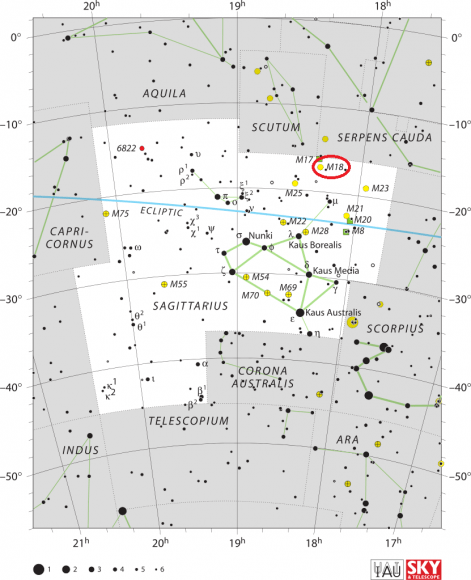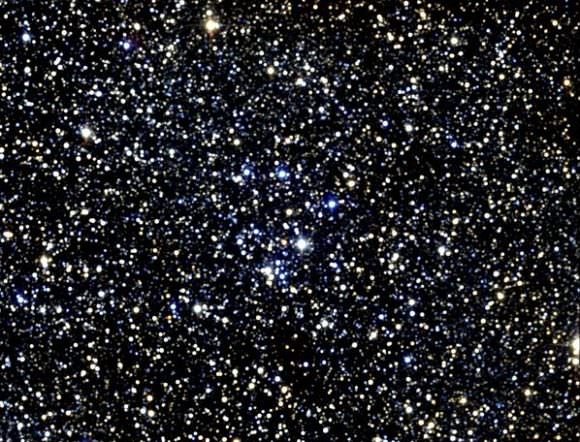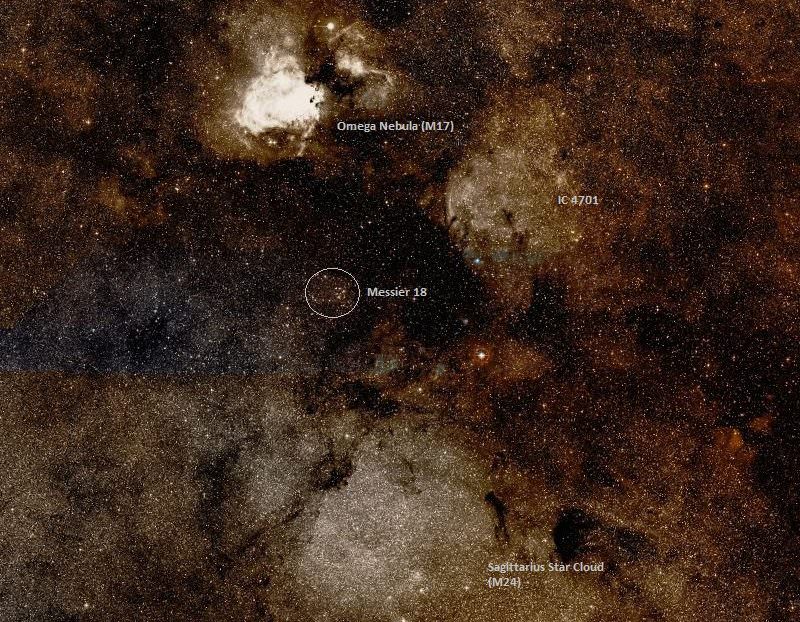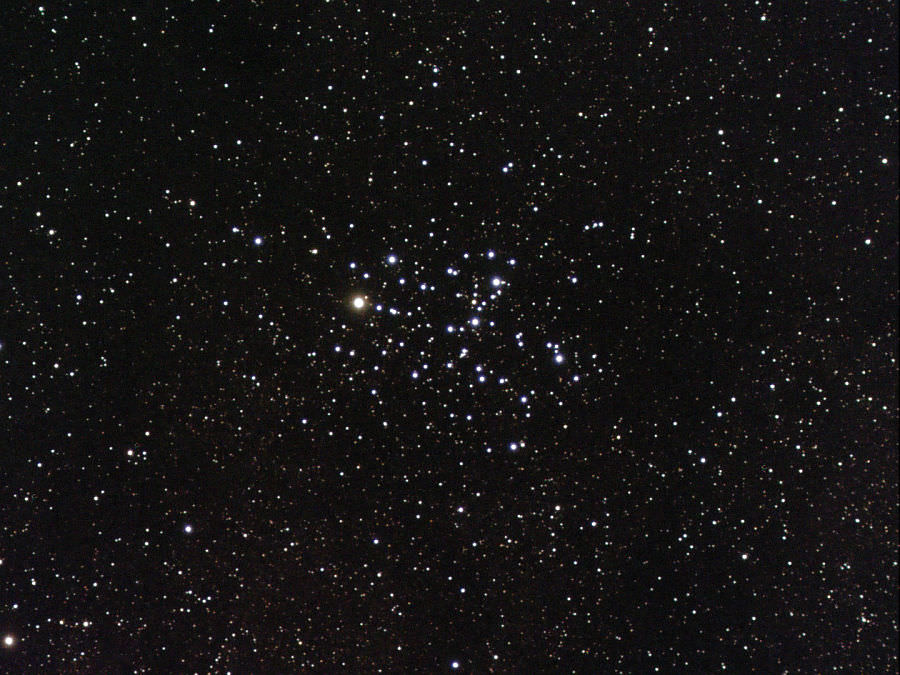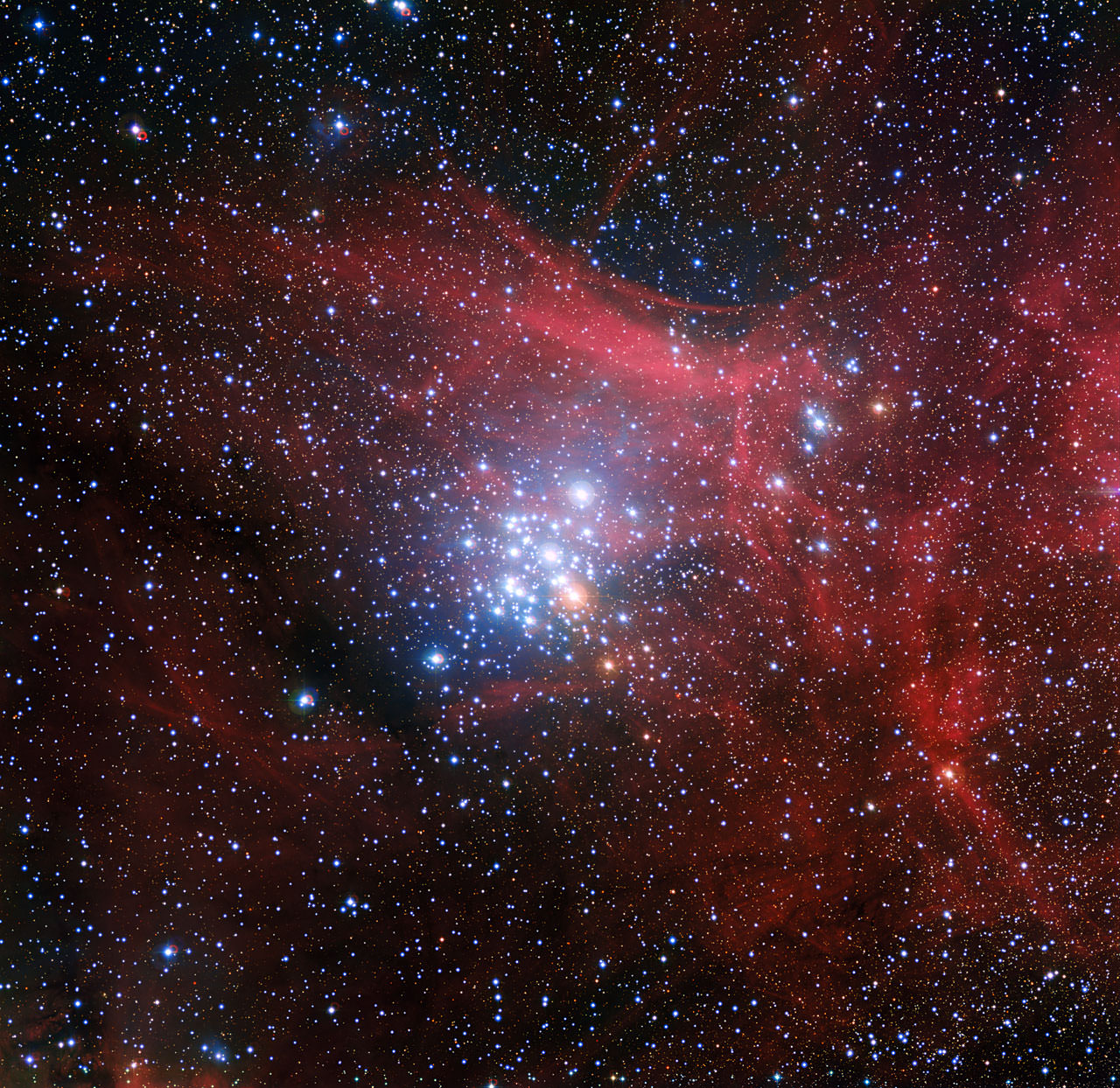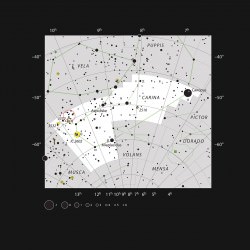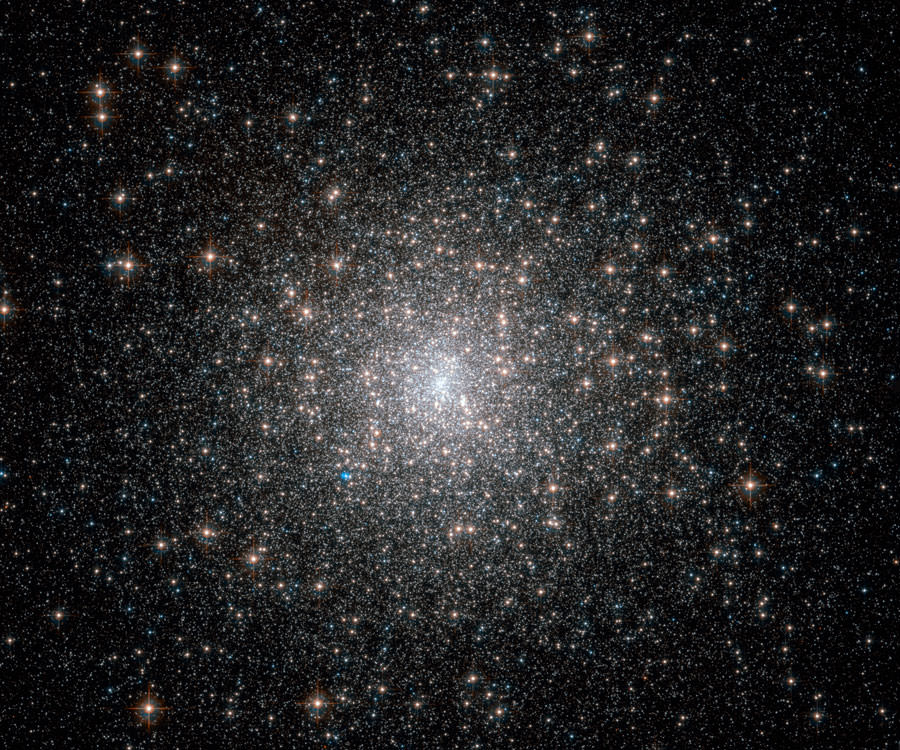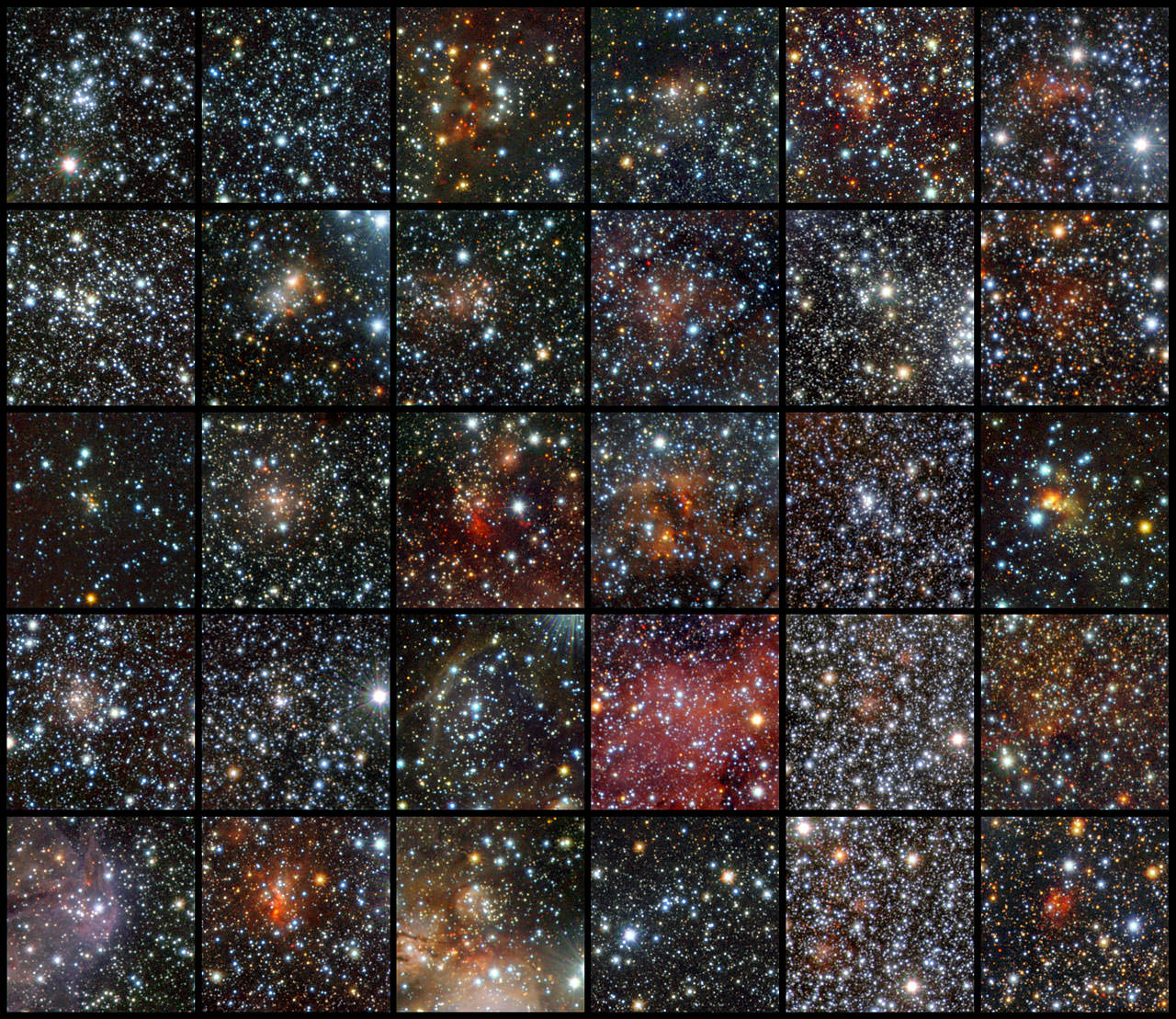Greetings, fellow SkyWatchers! This looks like a great week to take in some galactic star clusters and enjoy the Andromeda Galaxy! Some lucky viewers are in for a Mars occultation event and everyone wins with a meteor shower. What’s that, you say? Darn right. This week is also the time of the Autumnal Equinox! When ever you’re ready to learn more, just meet me in the back yard…
Monday, September 17 – Today in 1789, William Herschel discovered Saturn’s moon Mimas.
Tonight we’ll hunt with the “Fox” as we head to Vulpecula to try two more open star cluster studies. The first can be done easily with large binoculars or a low power scope. It’s a rich beauty that lies in the constellation of Vulpecula, but is more easily found by moving around 3 degrees southeast of Beta Cygni.
Known as Stock 1, this stellar swarm contains around 50 or so members of varying magnitudes that you will return to often. With a visual magnitude of near 5, loose associations of stars – like Stock clusters – are the subject of recent research. The latest information indicates that the members of this cluster are truly associated with one another.
A little more than a degree to the northeast is NGC 6815 (Right Ascension:19 : 40.9 – Declination: +26 : 51). While this slightly more compressed open cluster has no real status amongst deep sky objects, it is another one to add to your collection of things to do and see!
Tuesday, September 18 – Tonight we’ll start with an asterism known as the “Coat Hanger,” but it is also known as Brocchi’s Cluster, or Collinder 399. Let the colorful double star Beta Cygni – Albireo – be your guide as you move about 4 degrees to its south-southwest. You will know this cluster when you see it, because it really does look like a coat hanger! Enjoy its red stars.
First discovered by Al Sufi in 964 AD, this 3.5 magnitude collection of stars was again recorded by Hodierna. Thanks to its expansive size of more than 60 arc minutes, it escaped the catalogues of both Messier and Herschel. Only around a half dozen stars share the same proper motion, which may make it a cluster much like the Pleiades, but studies suggest it is merely an asterism…but one with two binary stars at its heart.
And for larger scopes? Fade east to the last prominent star in the cluster and power up. NGC 6802 (Right Ascension: 19 : 30.6 – Declination: +20 : 16) awaits you! At near magnitude 9, Herschel VI.14 is a well compressed open cluster of faint members. The subject of ongoing research in stellar evolution, this 100,000 year old cluster is on many observing challenge lists!
Wednesday, September 19 – On this day in 1848, William Boyd was watching Saturn – and discovered its moon Hyperion. On this date a moon will be on everyone’s mind as our Moon occults Mars (Pacific, South America, SW Atlantic). Be sure to check information such as the International Occultation Timing Assoication (IOTA) for specific details in your area. Even if you aren’t in a position to catch the occultation, it will still make a splendid scene! Also today in 1988, Israel launched its first satellite. How long has it been since you’ve watched an ISS pass or an iridium flare? Both are terrific events that don’t require any special equipment to be seen. Be sure to check with Heavens Above for accurate times and passes in your location and enjoy!
Tonight we again visit the M15 (Right Ascension: 21 : 30.0 – Declination: +12 : 10) globular and learn more about the scale of the Universe – circa 1900. On a decent night, a modest telescope will resolve about a dozen 13th magnitude stars outside M15?s core region. Most of these stars are red giants with absolute magnitudes of -2. Such stars appear 15 magnitudes fainter than they would be if they were at an astronomically standardized distance. Based on this 15 magnitude loss in intensity, we should be able to figure out how far away M15 is, but this is circular reasoning. In the early 1900s, astronomers didn’t know that the brightest stars in M15 were absolute magnitude -2. They first needed to know how far away the globular was to make sense of that.
Here’s where the H-R diagram helps out.
The most massive and swollen red giants (those nearing the end of their lives such as Betelgeuse and Antares) can be as luminous as absolute magnitude -6, but you can’t assume that the brightest red giants in a globular cluster are as bright as Antares and Betelgeuse. Why? Because we later discovered that all stars in a globular cluster entered the main sequence about the same time – some 12 billion years ago. Meanwhile, the very brightest ones – the Denebs – are no longer around. They exited the main sequence, became red giants and exploded a long, time ago, and possibly in a dwarf galaxy far, far away!
Now let’s take a a stellar tour of Lyra! First we’ll look at a double which has a close separation – Epsilon Lyrae. Known to most of us as the “Double Double,” look about a finger width northeast of Vega. Even the slightest optical aid will reveal this tiny star as a pair, but the real treat is with a telescope – for each component is a double star! Both sets of stars appear as primarily white and both are very close to each other in magnitude. What is the lowest power that you can use to split them?
Now let’s head for the northeast corner of the little parallelogram that is part of Lyra for easy unaided eye and binocular double Delta 1 and 2 Lyrae.
The westernmost Delta 1 is about 1100 light-years away and is a class B dwarf, but take a closer look at brighter Delta 2. This M-class giant is only 900 light-years away. Perhaps 75 million years ago, it, too, was a B class star, but it now has a dead helium core and it keeps on growing. While it is now a slight variable, it may in the future become a Mira-type. A closer look will show that it also has a true binary system nearby – a tightly matched 11th magnitude system. Oddly enough they are the same distance away as Delta-2 and are believed to be physically related.
Thursday, September 20 – Now let the Moon head west, because on this night in 1948, the 48? Schmidt telescope at Mt. Palomar was busy taking pictures. The first photographic plate was being exposed on a galaxy by the same man who ground and polished the corrector plate for this scope – Hendricks. His object of choice was reproduced as panel 18 in the Hubble Atlas of Galaxies and tonight we’ll join his vision as we take a look at the fantastic M31 – the Andromeda Galaxy.
Seasoned amateur astronomers can literally point to the sky and show you the location of M31 (Right Ascension: 0 : 42.7 – Declination: +41 : 16), but perhaps you have never tried. Believe it or not, this is an easy galaxy to spot even under the moonlight. Simply identify the large diamond-shaped pattern of stars that is the “Great Square of Pegasus.” The northernmost star is Alpha, and it is here we will begin our hop. Stay with the north chain of stars and look four finger-widths away for an easily seen star. The next along the chain is about three finger-widths away… And we’re almost there. Two more finger-widths to the north and you will see a dimmer star that looks like it has something smudgy nearby. Point your binoculars there, because that’s no cloud – it’s the Andromeda Galaxy!
Friday, September 21 – And what was Sir William Herschel doing on this date a couple of centuries ago? You can bet he was out telescoping; and his discoveries on this night were many. How about if we take a look at two logged on September 21 which made the Herschel “400? list?
Our first stop is northern Cygnus for NGC 7086 (RA 21 30 30 Dec +51 35 00). Located on the galactic equator about five degrees west of Beta Cephei, our target is an open cluster. At magnitude 8.4, this loose collection will be difficult for the smaller scope, and show as not much more than an arrow-like asterism. However, larger scopes will be able to resolve many more stars, arrayed in long loops and chains around the brighter members. Although it’s sparse, NGC 7086 has been studied for metal abundance, galactic distance, membership richness, and its luminosity function. Be sure to mark your notes for H VI.32, logged by Herschel in 1788.
Now hop on over to Andromeda for NGC 752 (RA 01 57 41 Dec +37 47 06). You’ll find it just a few degrees south of Gamma and in the field north of star 56. Located 1300 light-years away, there’s a strong possibility this cluster was noted first by Hodierna before being cataloged by Herschel on this night (1786). At near magnitude 5, this “400? object is both large and bright enough to be seen in binoculars or small telescopes, and people have often wondered why Messier did not discover it. The star-studded field containing about 70 members of various magnitudes belong to H VII.32 – a very old cluster which has more recently been studied for its metallicity and the variations in the magnetic fields of its members. Enjoy them both tonight! Sir William did…
Saturday, September 22 – Today marks the universal date of Autumnal Equinox. Enjoy this “equal” period of day and night!
Tonight we’ll return again to Vulpecula – but with a different goal in mind. What we’re after requires dark skies – but can be seen in both binoculars and a small telescope. Once you’ve found Alpha, begin about two fingerwidths southeast and right on the galactic equator you’ll find NGC 6823 (Right Ascension: 19 : 43.1 – Declination: +23 : 18).
The first thing you will note is a fairly large, somewhat concentrated magnitude 7 open cluster. Resolved in larger telescopes, the viewer may note these stars are the hot, blue/white variety. For good reason. NGC 6823 only formed about 2 billion years ago. Although it is some 6000 light-years away and occupies around 50 light-years of space, it’s sharing the field with something more – a very large emission/reflection nebula, NGC 6820 (Right Ascension: 19 : 43.1 – Declination: +23 : 17).
In the outer reaches of the star cluster, new stars are being formed in masses of gas and dust as hot radiation is shed from the brightest of the stellar members of this pair. Fueled by emission, NGC 6820 isn’t always an easy visual object – it is faint and covers almost four times as much area as the cluster. But trace the edges very carefully, since the borders are much more illuminated than the region of the central cluster. Take the time to really observe this one! Its processes are very much like those of the “Trapezium” area in the Orion nebula. Be sure to mark your observing notes. NGC 6823 is Herschel VII.18 and NGC 6820 is also known as Marth 401!
Now we’re off to a spectacular open cluster – NGC 6940. At close to magnitude 6, you’ll find this unsung symphony of stars around three fingerwidths southwest of Epsilon Cygni (RA 20 34 24.00 Dec +28 17 -0.0).
Discovered by Sir William Herschel on Oct 15, 1784, and logged as H VIII.23, this intermediate aged galactic cluster will blow your mind in larger aperture. Visible in binoculars, as size increases the field explodes into about 100 stars in a highly compressed, rich cloud. Although it is not an often visited cluster, it is part of many observing challenge lists. Use low power to get the full effect of this stunning starfield!
Sunday, September 23 – On this day in 1846, Johann Galle of the Berlin Observatory makes a visual discovery. While at the telescope, Galle sees and identifies the planet Neptune for the first time in history. On this day in 1962, the prime time cartoon “The Jetsons” premiered. Think of all the technology this inspired!
Rather than doing lunar work tonight, why not wait until the Moon has westered and have an “Autumn Planetary Marathon”? Start easy with M57 between Gamma and Beta Lyrae. Head north-northwest to the “Cat’s Eye” (NGC 6543) roughly between Delta and Zeta Draconis – you’ll need your charts for this one! Now southwest to the “Blinking Planetary” (NGC 6543) – found less than three degrees east-southeast of Iota Cygni. Continue east-southeast a little less than 6 degrees past Deneb to the “Box Planetary” – NGC 7027. Now on to the brightest of the ten – M27. The “Dumbbell Nebula” is located a little more than 3 degrees north of Gamma Sagittae. Now drop two hand spans south to the “Little Gem” (NGC 6818) – around 7 degrees northeast of Rho Sagittarii.
One hand span east of the “Little Gem” leads you toward the “Saturn Nebula” in Aquarius – a little more than a degree west of Nu. Now it’s a huge jump of more than two hand spans west-northwest to tiny NGC 6572 – located around two finger-widths south-southeast of 72 Ophiuchi. Continue on to compact NGC 6790 a finger-width south of Delta Aquilae. Did you find them all? Well, if the “Cat’s Eye” is the toughest to locate, then NGC 6790 is the hardest to identify. Good going! But don’t stop now… Two hand spans west-northwest leads to NGC 6210 – best located using pointer stars Gamma and Beta Herculis. Excellent work!
Ready for the finale? Now, kick back… relax… and watch the Alpha Aurigid meteor shower. Face northeast and look for the radiant near Capella. The fall rate is around 12 per hour, and they are fast and leave trails!
Until next week? Wishing you clear skies…
